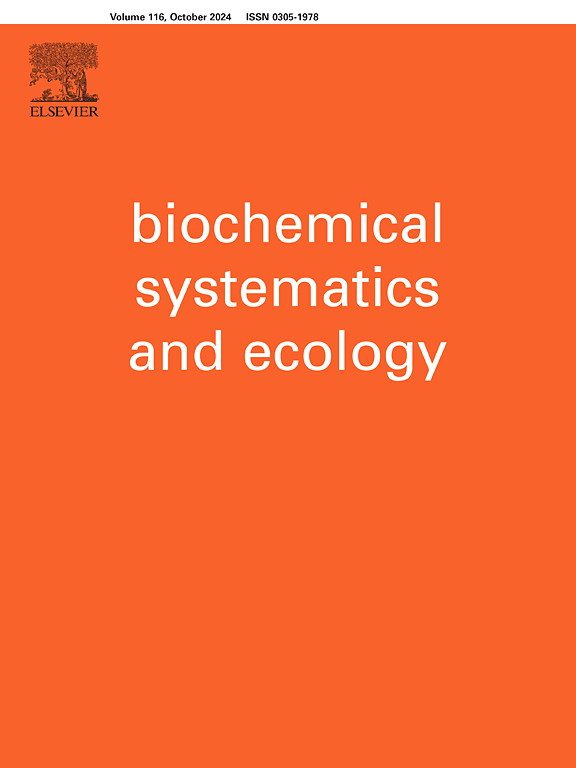HS-SPME-GC/MS analysis of the volatile components of the resins of different Commiphora Jacq. Species collected in Socotra Island
IF 1.4
4区 生物学
Q4 BIOCHEMISTRY & MOLECULAR BIOLOGY
引用次数: 0
Abstract
In this paper, the volatile phytochemical pattern of the resins of five Commiphora Jacq. species collected in Socotra Island was reported. Different populations were studied, some of which for the first time, by using head space-solid phase microextraction (HS-SPME) sampling technique to collect the volatiles emitted from these species. All the captured volatile compounds in the accessions were identified and quantified by means of Gas-Chromatography/Mass Spectrometry (GC/MS). The obtained results highlighted the presence of terpene compounds, mainly monoterpenes and sesquiterpenes, which followed a different trend among the studied species in accordance with the ecology of the collection areas of the species. Sesquiterpenes were predominant in C. kua and, in part, in C. ornifolia; monoterpenes were predominant in C. planifrons and C. parvifolia, whereas oxygenated monoterpenes were predominant in C. socotrana. A high number of the so-called other volatile components were found in C. planifrons. The dominant compounds were γ-cadinene in both accessions of C. kua, β-eudesmol in the first accession of C. ornifolia and δ-cadinene in its second accession, limonene in both accessions of both C. planifrons and C. parvifolia, terpinen-4-ol in both accessions of C. socotrana. The meaning of the data was considered under the chemophenetic, ecological and ethnobotanical aspects.

HS-SPME-GC/MS分析不同种类黄花草树脂挥发性成分。在索科特拉岛收集的物种
本文研究了五种金针花树脂的挥发性植物化学特征。报告了在索科特拉岛收集到的物种。采用头部空间-固相微萃取(HS-SPME)取样技术,对不同种群(部分为首次)进行了研究。采用气相色谱/质谱法(GC/MS)对样品中捕获的挥发性化合物进行鉴定和定量。结果表明,所研究的物种中存在萜类化合物,主要是单萜类和倍半萜类化合物,根据物种采集区的生态环境不同,存在不同的趋势。倍半萜类化合物在山茱萸中含量最高,在山茱萸中含量最低;扁铁杉和细叶铁杉以单萜类化合物为主,而野铁杉以氧合单萜类化合物为主。在雪兰中发现了大量所谓的其他挥发性成分。优势化合物分别为:花楸属两种植物的γ-cadinene、花楸属一种植物的β-eudesmol、花楸属二种植物的δ-cadinene、花楸属两种植物的柠檬烯、花楸属两种植物的terpinen-4-ol。这些数据的意义在化学化学、生态学和民族植物学方面进行了考虑。
本文章由计算机程序翻译,如有差异,请以英文原文为准。
求助全文
约1分钟内获得全文
求助全文
来源期刊

Biochemical Systematics and Ecology
生物-进化生物学
CiteScore
3.00
自引率
12.50%
发文量
147
审稿时长
43 days
期刊介绍:
Biochemical Systematics and Ecology is devoted to the publication of original papers and reviews, both submitted and invited, in two subject areas: I) the application of biochemistry to problems relating to systematic biology of organisms (biochemical systematics); II) the role of biochemistry in interactions between organisms or between an organism and its environment (biochemical ecology).
In the Biochemical Systematics subject area, comparative studies of the distribution of (secondary) metabolites within a wider taxon (e.g. genus or family) are welcome. Comparative studies, encompassing multiple accessions of each of the taxa within their distribution are particularly encouraged. Welcome are also studies combining classical chemosystematic studies (such as comparative HPLC-MS or GC-MS investigations) with (macro-) molecular phylogenetic studies. Studies that involve the comparative use of compounds to help differentiate among species such as adulterants or substitutes that illustrate the applied use of chemosystematics are welcome. In contrast, studies solely employing macromolecular phylogenetic techniques (gene sequences, RAPD studies etc.) will be considered out of scope. Discouraged are manuscripts that report known or new compounds from a single source taxon without addressing a systematic hypothesis. Also considered out of scope are studies using outdated and hard to reproduce macromolecular techniques such as RAPDs in combination with standard chemosystematic techniques such as GC-FID and GC-MS.
 求助内容:
求助内容: 应助结果提醒方式:
应助结果提醒方式:


